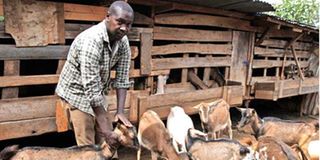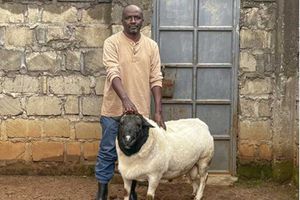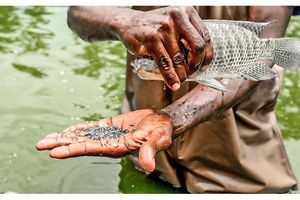
Bildad Rotich in Konoin village in Kiptagich, Nakuru County.
It is around noon as we manoeuvre the murram road before arriving in Konoin village, Kuresoi South Sub County, Nakuru.
The village is surrounded by tea plantations, trees and new houses. Bildad Rotich, 31, shows us where he keeps his dairy goats.
“Before switching to goats, I used to rear dairy cows. The high cost of feeds meant I was incurring more on taking care of the cows than what I was getting from them,” the 31-year-old says, adding that he also spent money getting milk from neighbours when the cows had been dried.
Rotich was advised by a friend to buy a dairy goat. The friend had said he got four litres of milk from his goat a day.
“I sold my two cows for Sh80,000, an amount that was enough to buy a mature Alpine does,” Rotich tells the Seeds of Gold.
He adds that through his friend, he bought two female German Alpines and a buck for Sh31,000 and used some of the balance to build their shed.
Five months later, Rotich began milking one of the goats. True to the friend’s word, he got four litres every day, more than enough for his family.
Selling the surplus to neighbours was challenging as they were used to cow milk. With time, he had customers.
A year after starting the venture, milk production had increased as Rotich now had six dairy goats, each producing five litres a day.
He has no regrets abandoning the dairy cow business as goats consume less feed and their management practices are low.
He says the cost of producing milk from a cow is 10 times that of a goat, adding that a doe gives birth to at least two kids thereby increasing the herd rapidly.
“I feed the animals once a day. I now have 20 milking goats, getting at least 100 litres of milk a day,” he says.

Bildad Rotich, 31, feeds his dairy goats at Konoin village in Kiptagich, Nakuru County.
A litre of goat milk goes for Sh90, compared to Sh40 for a cow. Rotich has different breeds recommended by top goat keepers, including British Alpine, Saanen and Toggenburg.
He hopes to increase his herd to 100 before the end of this year. Rotich has 32 goats in total, including kids and few bucks.
He intends to be a goat breeder and sell his animals to groups and large-scale farmers in Kenya and abroad.
Rotich attributes the good milk yields to proper feeding and having the recommended breeds.
He also grows tea. Part of his farm is for Napier and elephant grass that he gives the goats. He supplements the feed with dairy meal in order to increase milk production. As the kids are weaned, he gives them pellets.
The farmer uses a chuff-cutter to chop the grass. It is near a raised pen with feeding troughs, roofed with iron sheets and well-ventilated.
“My animals rarely get sick but I deworm the mature goats every three months and the young ones after every two months,” Rotich says.
He gathers the droppings daily and collects the mound after three weeks, which he uses as manure for his cabbages and tea.
With the manure from the goat droppings, Rotich no longer buys fertiliser.
Rotich rarely sells his goats. When he does, a mature female goat goes for Sh30,000 while a buck is Sh25,000.
“I was one of the members of the Dairy Goat Association of Kenya but quit to pursue an independent path. I also had an agro-vet shop but closed it in order to monitor my goats,” he says.
He has not hired anyone to look after the animals.
Rotich’s wife, Stella Chepkemoi, says dairy goat farming is more cost-effective than having cows.
“The work is minimal and the goats eat little,” she says.
Rotich attends agricultural fairs and does research on the internet to get more insights in dairy goat farming.
Getting quality bucks to serve females is the main challenge. Rotich urges county governments to help dairy goat farmers do so. He says extension officers need to sensitise and train goat farmers on how to keep, treat and identify diseases as happens to avocado growing.
“County governments should also think of providing coolers for dairy goat farmers,” he says.
Molo Livestock Officer, Antony Kariuki, advises goat farmers to ensure proper housing for their animals.
“They also need to vaccinate their goats against diseases. We urge them to talk to experts on the best management practices,” Kariuki says.









